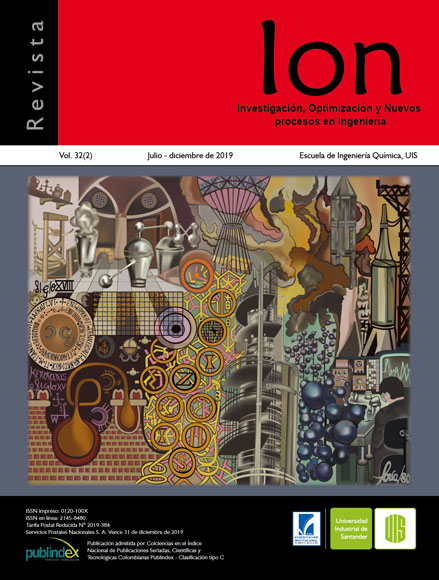Anaerobic co digestion from cattle manure, pig manure and horse manure as an alternative to improve the energy potential in household digesters
Published 2019-11-22
Keywords
- biomethane potential,
- manures,
- mixture
How to Cite
Abstract
The manures from bovine (EB), equine (EE) and porcine (EP) are among the most abundant renewable waste in agroecosystems, which can be managed and avoid contamination problems, and one option is a stabilization by anaerobic digestion (DA). This study was carried out to reflect the biochemical and microbiological behavior of mixtures of dilutions from bovine, equine and porcine manures and according to the proportions described by the simplex experiment design {3,3} augmented with axial points, having consider as response variables the potential of biomethanation (PBM) for the biochemical part and the synergy (Φ) for the microbiological part. Characterization of the physical properties was performed before performing the experiments for the determination of the PBM. For the DA of the case studies, the equine-bovine manure mixture with a ratio in % P / P 8,3% and 16,7% respectively and remaining in water, generated the greatest synergy 3,63 and achieved the second-best potential 46,56 N-lCH4 / kg SV, showing how equine manure is an excellent co-substrate for bovine manure and equine-porcine manure mixture with a ratio in % P / P 16,7% and 8,3% respectively and remaining in water, reached the highest PBM of 51,22 N-lCH4 / kg SV with a synergy 3,09 being the second-highest among all digestions, indicating how these manures complement their biochemical and microbiological qualities to obtain a greater result. As for the analysis of the digested energy potential, the highest energy production is 0,43 kWh / kg from the EE-EP mixture and the substrate that generates the least amount of energy is bovine manure with 0,08 kWh / kg of sample.
Downloads
References
[2] Martí H. Biodigestores familiares. Guía de diseño y manual de instalación: Biodigestores de polietileno tubular de bajo costo para trópico, valle y altiplano. Bolivia: Cooperación Túcnica Alemana, La Paz (Bolivia); 2008.
[3] SAGARPA. Utilización de estiércoles. México: Secretaria de Desarrollo rural. Dirección general de apoyo para el desarrollo rural de Montecillo, Estado de México; 2000.
[4] Angelidaki I, Karakashev D, Batstone DJ, Plugge CM, Stams AJM. Biomethanation and its potential. Met. in Enzymology. 2011;494:327-51.
[5] Holliguer C, Alves M, Andrade D, Angelidaki I, Astals S, Baier U, et al. Towards a standardization of biomethane potential tests.Water Sci Technol. 2016;74: 2515-2522.
[6] Astals S, Batstone D, Tait S, Jensen P.Development and validation of a rapid test for anaerobic inhibition and toxicity. Water Res. 2015;81:208-215.
[7] Naik L, Gebreegziabher Z, Tumwesige V, Babulo Balana B, Mwirigi J, Austin G. Factors determining the stability and productivity of small scale anaerobic digesters. Biomass Bioenergy. 2014;70:51-57.
[8] Garfí M, Martí-Herrero J, Garwood A, Ferrer I. Household anaerobic digesters for biogas production in Latin America: A review. Renew. and Sustain. Eng. Rev. 2016;60:599-614.
[9] Castro L, Escalante H, Jaimes-Estévez J, Díaz LJ, Vecino K, Rojas G, Mantilla L. Low cost digester monitoring under realistic conditions: Rural use of biogas and digestate quality. Bioresource tech. 2017;239:311-7.
[10] Escalante H, Castro L, Amaya MP, Jaimes L, Jaimes-Estévez J. Anaerobic digestión of cheese whey: Energetic and nutritional potential for the dairy sector in developing countries. Waste Management. 2018;71:711-8.
[11] Castro L, Mojica A, Tovar, Quintero M, Escalante H. Efecto de la dilución agua/estiércol sobre la actividad microbiana y el potencial de biometanización en procesos anaerobios. RedBioLac. 2018.
[12] Cavinato C, Cavinato F, Bolzonella D, Pavan P. Thermophilic anaerobic co-digestion of cattle manure with agro-wastes and energy crops: comparison of pilot and full scale experiences. Bioresource tech. 2011;101(2):545-50.
[13] Shah F, Mahmood Q, Rashid N, Pervez A, Raja I, Shah M. Co-digestion, pretreatment and digester design for enhanced methanogenesis. Renew. and Sustain. Eng. Rev. 2015;42:627-42.
[14] Rice EW, Baird RB, Eaton AD. Standard methods for the examination of water and wastewater. 23 ed. United States: American Public Health Association; 2017.
[15] Lombardi M, Tricase C. State of the art and prospects of Italian biogas production from animal sewage. Technicaleconomic considerations. Renew. Eng. 2009;34(3):477-85.
[16] Castro L, Escalante H, Lambis L, Marín J. Synergistic effects in anaerobic codigestion of chicken manure with industrial wastes. Revista DYNA. 2018;85:135-141.
[17] Labatut RA, Angenent LT, Scott NR. Biochemical methane potential and biodegradability of complex organic substrates. Bioresour. Tech. 2011;102(3):2255-64.
[18] André L, Pauss A, Ribeiro T. Solid anaerobic digestion: State-of-art, scientific and technological hurdles. Bioresource tech. 2018;247:1027-37.
[19] Fernández C, Martinez E, Moran A, Gómez X. Procesos biológicos para el tratamiento de lactosuero con producción de biogás e hidrógeno. Revisión bibliográfica. rev.ion. 2016;29:47-62.
[20] Mata-Alvarez J, Dosta D, Romero-Güiza J, Fonoll X, Peces M, Astals S. A critical review on anaerobic co-digestion achievements between 2010 and 2013. Renew. and Sustain. Eng. Rev. 2014;36:412-27.

